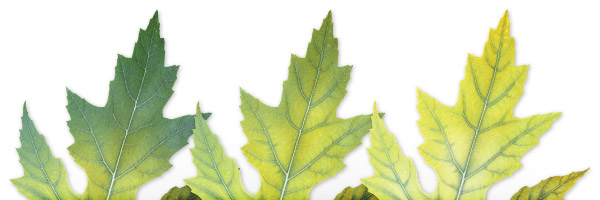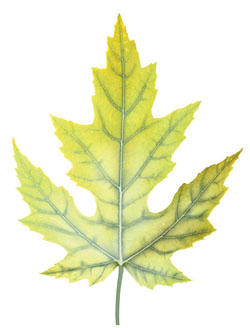Iron deficiency guide
Iron is a vital element for plant life. Iron has a number of important functions in the overall metabolism of the plant and is essential for the synthesis of chlorophyll. In general, iron is poorly absorbed by the plant. It can only be sufficiently taken up by the roots in certain forms and under proper conditions.
Potting mixes seldom contain too little iron, but it is possible that forms of iron that can be absorbed by the plant are lacking. The absorbency of iron is strongly dependent on the pH. Usually, there is sufficient iron present in absorbable form in acidic potting mixes.
About iron in short
- What is it and what does it do?
- Iron has a number of important functions in the plant’s overall metabolism and is essential for the synthesis of chlorophyll.
- What can you see?
- Strong yellowing of especially the young leaves and growth shoots between the veins.
- What can you do?
- The best thing is to spray the plants with a watery solution of EDDHA or EDTA chelates.

Symptoms of a deficiency
Iron deficiency can occur during periods of heavy growth or high plant stress and is characterized by a strong yellowing of the young leaves and the growth shoots between the veins. This occurs chiefly because iron is not mobile in the plant. The young leaves can’t draw any iron from the older leaves. With a serious iron shortage, the older leaves and the smaller veins in the leaf can also turn yellow.
Development of a deficiency
- Green/yellow chlorosis, from inside to the outside in the younger leaves and in the growth shoots. The veins remain mostly green.
- Continued yellowing of the leaves to sometimes almost white. Also, large leaves turn yellow. This inhibits growth.
- In serious cases the leaves show necrosis, and the plant’s growth and flowering are inhibited.

Reasons for a deficiency
- The pH in the root environment is too high (pH> 6,5).
- The root environment contains a lot of zinc and/or manganese.
- The concentration of iron is too low in the root environment.
- The root temperature is low.
- The root medium is too wet, causing the oxygen supply in the roots to stagnate.
- The root system functions inefficiently due to damaged, infected or dead roots.
- There is too much light on the nutrition tank; light promotes the growth of algae. Algae also use up the iron and break down iron chelates.
Solutions for a deficiency
- Lower the pH.
- Iron chelates can be added to the substrate.
- Drainage can be improved, or the ground temperature can be increased.
- A leaf nutrient with iron chelates can possibly be applied. If a good fertilizer is used with hydroponic growing, an iron deficiency is almost out of the question.
- The best thing you can do is to spray the plants with a watery solution of EDDHA (max. 0.4 grams per gallon) or EDTA chelates (max. 2 grams per gallon).